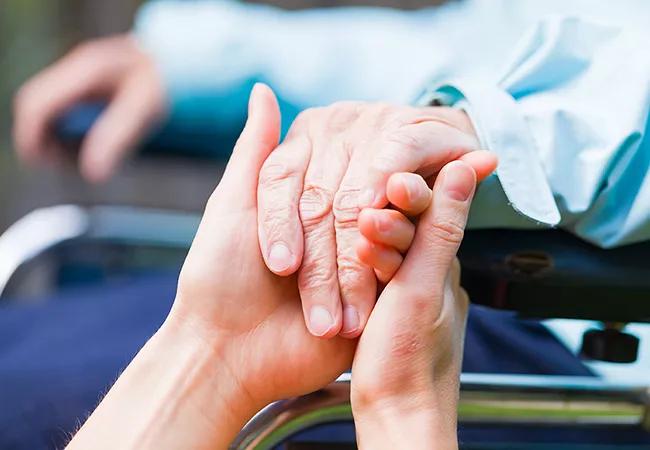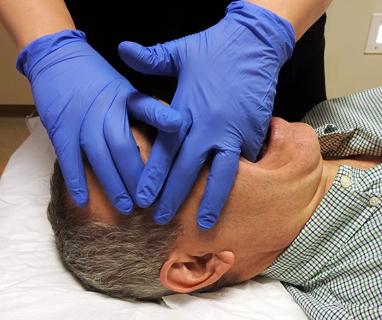Care improves quality of life

Consider this real-life scenario: A patient with advanced Parkinson’s disease who is suffering from dysphagia is at high-risk for aspirational pneumonia.
Advertisement
Cleveland Clinic is a non-profit academic medical center. Advertising on our site helps support our mission. We do not endorse non-Cleveland Clinic products or services. Policy
The 85-year-old patient is also a risk for malnutrition. She is rapidly losing weight, in part, because she doesn’t care for the special diet — soft foods and drinks with added thickeners so they are swallowed more slowly — that her internal medicine doctor prescribes to protect her from the potentially life-threatening pneumonia.
So what is the best course of action? Should the patient be informed of the risks and allowed to eat what she wants? Should her doctor insist on a feeding tube to ensure she gets nutrition? When should her family members be consulted?
This is the kind of conundrum that patients with advanced diseases, their family members and their physicians face all the time. And, too often, they find they have not spent enough time contemplating what will bring the best quality of life to the patient — as defined by the patient and his or her family.
“Sometimes a patient’s health changes suddenly or a disease progresses more rapidly than expected,” says Laura Shoemaker, DO, MS, Director of Palliative Medicine at Cleveland Clinic. “When that happens, I can’t tell you how often I meet people in a hospital setting such as the ICU and the patient is on advanced life support or has had a feeding tube placed and are receiving artificial nutrition and the family says, ‘We never wanted any of this. How did this happen?”
Navigating today’s healthcare system can be difficult enough when you are healthy but when someone has a serious disease — and is facing pain, uncertainty, financial strain, loss of independence — the stakes are higher and the stress on patients and family members is intense.
Advertisement
Bringing in a palliative care team — doctors, nurses, social workers and chaplains — can help patients and family members navigate a wide range of concerns and needs.
And research shows it works: a recent review and meta-analysis published in the November 2016 issue of JAMA, for instance found that palliative care interventions were associated with improvements in patient quality of life and symptom burden.
Another study published in the August 2010 issue of the New England Journal of Medicine found that patients with metastatic non-small-cell lung cancer who received early palliative care had significant improvements in quality of life and mood. Compared to similar patients who did not receive early palliative care, these patients had less aggressive care, but survived longer.
Specialty palliative care teams manage pain or other symptoms the patient is feeling, work to relieve psychological distress both in patients and caregivers, advise on financial concerns and provide spiritual guidance.
“It’s holistic, compassionate care,” Dr. Shoemaker says. “It includes all the different domains of suffering: physical, emotional, social and spiritual.”
Palliative care specialists must have expert communication skills so they can help patients and family members have critical discussions along the course of their illness. For example, after a cancer patient’s oncologists initially presents treatment options, the palliative care doctor or nurse may then offer additional conversations about those options with special attention to the patient’s personal preferences.
Advertisement
For example, Dr. Shoemaker says, some patients may not want to endure the side effects of chemotherapy if there’s only a slim chance that they might extend their lives for a few weeks or months. Others, she says, might think, ‘I’m willing to do anything if there’s a chance of more time.’”
She adds: “Some people have really specific goals, maybe they’re trying to get to a child’s wedding or a granddaughter’s graduation. We really take those things into account when helping to advise treatment plans around their goals.”
Cleveland Clinic has had palliative care programs on its main campus at Taussig Cancer Institute since the 1990s but recently added programs to its regional hospitals, first at Hillcrest hospital in 2014, then at South Pointe hospital in 2015 and soon at Fairview hospital — in fall 2017 — the first program on Cleveland’s west side.
In addition to those inpatient programs, there are also outpatient clinics at Taussig Cancer Institute, the Hillcrest Cancer Center and, most recently at the Moll Cancer Center at Fairview Hospital. Finally Cleveland Clinic is bolstering its community-based palliative care program. “It’s a home-based program where nurses and doctors come to your home to help manage your care,” Dr. Shoemaker says. “It’s part of a continuum of care that we’re trying to build.”
“It’s all about access,” Dr. Shoemaker says. “We are trying to expand our services to the places where we can better connect with patients and families who need palliative care over the course of a serious illness.”
Advertisement
As an example, she points to a recent breast cancer patient she worked who was receiving chemotherapy, not to cure her disease, but to prolong her life. Dr. Shoemaker met the woman while she was in Hillcrest hospital due to pain from her metastases — which Dr. Shoemaker managed. Once the woman was discharged, she saw one of Dr. Shoemaker’s colleagues at Hillcrest’s outpatient cancer center to continue to manage her pain.
As the woman’s disease progressed, Dr. Shoemaker says, they had continual conversations about her preferences such as how long to continue her chemotherapy based on how it affected her quality of life. The palliative care team kept caring for the patient, she says, “throughout the course of her illness, including when she elected hospice and went on to die peacefully.”
All in all, Dr. Shoemaker says, “we spent two years caring for this woman and supporting her all the way through the course of her illness.”
Advertisement
Advertisement

Not if they meet at least one criterion for presumptive evidence of immunity

Essential prescribing tips for patients with sulfonamide allergies

Confounding symptoms and a complex medical history prove diagnostically challenging

An updated review of risk factors, management and treatment considerations

OMT may be right for some with Graves’ eye disease

Perserverance may depend on several specifics, including medication type, insurance coverage and medium-term weight loss

Abstinence from combustibles, dependence on vaping

An historical view of the disease